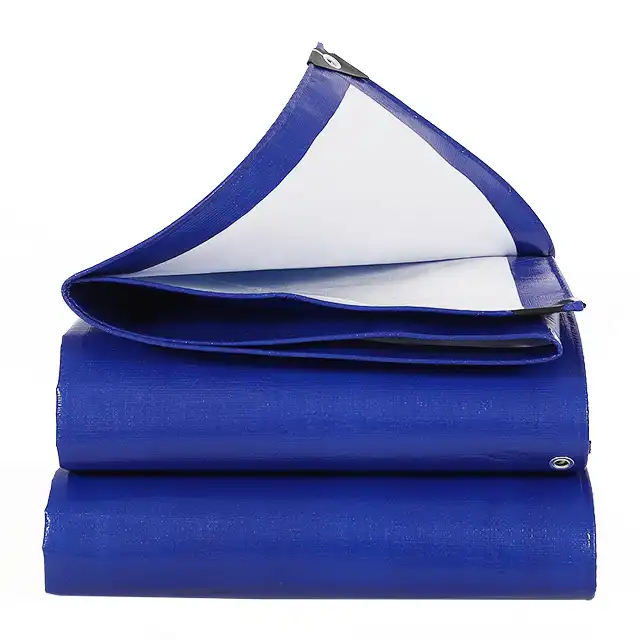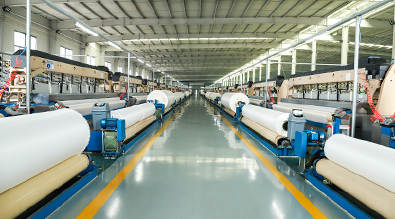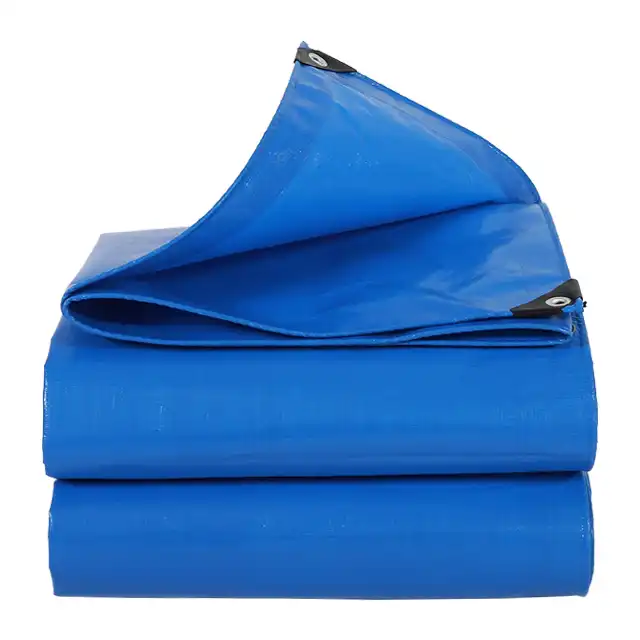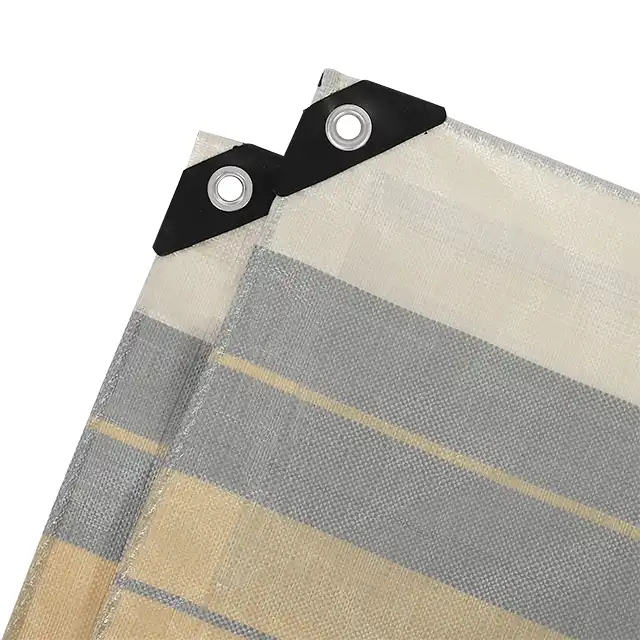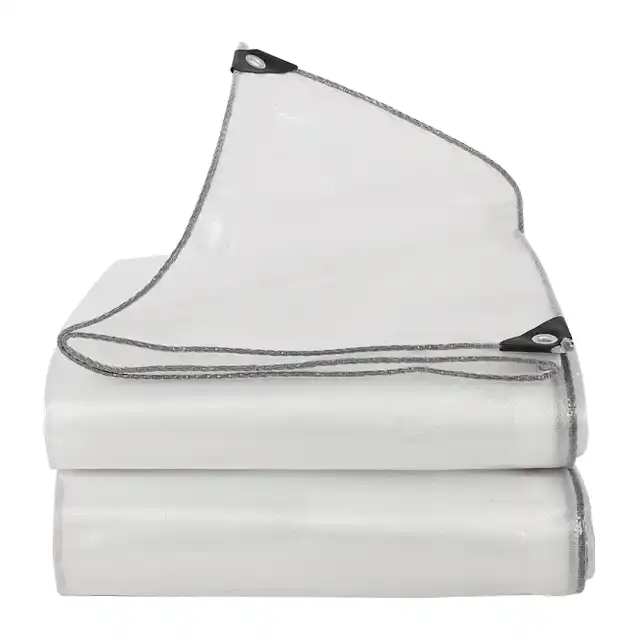What Makes Orange Tarpaulin Material Fully Waterproof?
In the realm of protective coverings,  stands out as a highly visible and remarkably waterproof solution for various applications. The secret behind the complete waterproofing capability of orange tarpaulin lies in its sophisticated manufacturing process and carefully selected materials. High-density polyethylene (HDPE) woven fabric forms the core structure, which is then laminated with low-density polyethylene (LDPE) coating on both sides, creating an impenetrable barrier against water. This dual-layer construction, combined with specialized weaving techniques and UV-resistant treatments, makes orange tarpaulin completely waterproof while maintaining durability in various weather conditions. The distinctive orange color not only provides high visibility for safety applications but also indicates the presence of UV inhibitors that extend the material's waterproof performance over time.
stands out as a highly visible and remarkably waterproof solution for various applications. The secret behind the complete waterproofing capability of orange tarpaulin lies in its sophisticated manufacturing process and carefully selected materials. High-density polyethylene (HDPE) woven fabric forms the core structure, which is then laminated with low-density polyethylene (LDPE) coating on both sides, creating an impenetrable barrier against water. This dual-layer construction, combined with specialized weaving techniques and UV-resistant treatments, makes orange tarpaulin completely waterproof while maintaining durability in various weather conditions. The distinctive orange color not only provides high visibility for safety applications but also indicates the presence of UV inhibitors that extend the material's waterproof performance over time.
The Science Behind Orange Tarpaulin's Waterproof Properties
Advanced Manufacturing Techniques for Water Resistance
The exceptional waterproofing capabilities of orange tarpaulin begin with cutting-edge manufacturing processes that transform basic materials into impermeable protective covers. At Linyi Shengde Plastic Co., Ltd., the production starts with high-tech extruding machines that create precise polyethylene yarns ranging from 400D to 2500D in thickness. These yarns are then meticulously woven using advanced water-jet looms, including unique 4m and 5m width fabric weaving machines imported from Korea. The tightly woven HDPE fabric creates the first defense against water penetration, with mesh counts typically ranging from 10×10 to 14×14 for medium-duty orange tarpaulin products. This precise weaving technique ensures there are minimal spaces between the yarns where water might penetrate. The factory's ability to produce fabric widths from 1.5m to 5m without joints further enhances the waterproof integrity by eliminating vulnerable seams where water could potentially enter. Professional technicians continuously monitor the quality throughout the production process, ensuring consistent waterproof performance across all orange tarpaulin products.
Multi-Layer Lamination Process for Complete Waterproofing
What truly makes orange tarpaulin fully waterproof is the sophisticated multi-layer lamination process applied after weaving. Using four large-scale coating machines, Linyi Shengde Plastic applies LDPE coating to both sides of the HDPE woven fabric. This coating process is critical to achieving 100% waterproof properties in orange tarpaulin materials. The lamination creates a continuous film that completely seals the woven structure, preventing any water molecules from passing through. The thickness of this coating, measured in mils (typically 7-12 mil for medium-duty tarps), directly influences the material's waterproof capabilities. The company's professional coating technicians precisely control the application temperature, pressure, and coating distribution to ensure uniform coverage without weak points. This dual-sided lamination not only makes the orange tarpaulin completely impervious to water but also adds significant tear resistance and durability. The finished product undergoes rigorous quality testing, including water pressure tests, to verify its waterproof integrity before being released for use in applications ranging from truck covers to aquaculture.
Chemical Treatments and Additives for Enhanced Water Repellency
Beyond the physical structure, orange tarpaulin's complete waterproofing is further enhanced through specialized chemical treatments and additives incorporated during manufacturing. UV inhibitors, comprising 1%-7% of the material composition, are particularly crucial as they prevent degradation of the waterproof coating when exposed to sunlight. These treatments give orange tarpaulin its distinctive bright color while providing protection against harmful ultraviolet rays that could otherwise compromise the material's waterproof properties over time. SENDOW TARPAULIN products also incorporate anti-freezing additives that maintain the material's flexibility and waterproof performance even in extreme cold conditions, preventing cracking that could lead to water penetration. Additionally, anti-corrosion compounds protect against chemical exposure that might degrade the waterproof barrier. The combination of these chemical enhancements creates a synergistic effect that significantly extends the waterproof lifespan of orange tarpaulin materials. This aspect is particularly important for applications in harsh environments where the tarpaulin must maintain its waterproof integrity despite exposure to varied weather conditions, chemicals, and physical stress.
Performance Factors of Waterproof Orange Tarpaulin
Weight and Density Specifications for Optimal Waterproofing
The weight and density of orange tarpaulin materials play a crucial role in determining their waterproof performance across different applications. Linyi Shengde Plastic Co. manufactures orange tarpaulin in varying weights ranging from lightweight 65gsm (grams per square meter) to heavy-duty 280gsm options. Medium-duty orange tarpaulin typically falls between 100gsm-180gsm, striking an optimal balance between waterproof performance and practical usability. This weight specification directly correlates with the density of the material—heavier tarps generally offer enhanced waterproof protection due to increased material thickness and reduced permeability. The manufacturing process ensures that even lighter-weight orange tarpaulin maintains complete waterproof properties through precise quality control of the HDPE weaving and LDPE coating processes. For applications requiring absolute waterproof integrity under significant water pressure, such as truck covers exposed to driving rain or aquaculture impermeable tarps, the company recommends higher weight specifications. The density of the weave, often expressed as mesh count, further enhances waterproofing—higher mesh counts (14×14) create tighter weaves with smaller gaps for the coating to seal, resulting in superior waterproof performance even in challenging conditions.
Seam Construction and Heat-Sealing Technology
While the material itself is crucial for waterproofing, the construction of seams and joints represents potential vulnerability points in any orange tarpaulin application. Linyi Shengde Plastic addresses this challenge through advanced heat-sealing technology utilized across seven specialized production lines. Unlike conventional stitching that creates needle holes where water could penetrate, heat-sealing fuses the material together by melting the LDPE coating at seam points, creating a continuous waterproof barrier across the entire tarpaulin surface. The company's seven units of huge heat-sealing machines enable precise temperature control during this critical process, ensuring strong bonds without compromising the integrity of the orange tarpaulin material. This technology allows for the production of completely waterproof tarps even in custom sizes and configurations. For applications requiring maximum waterproof performance, double-sealed or reinforced seams provide additional protection against water intrusion. The heat-sealing process also enables the incorporation of reinforced edges, grommets, and specialized features without compromising the waterproof integrity of the orange tarpaulin. These manufacturing capabilities support the company's ability to produce 100+ tons of fully waterproof tarpaulin sheets daily while maintaining consistent quality across all products.
Longevity of Waterproof Properties Under Various Conditions
The true test of orange tarpaulin's waterproofing effectiveness lies in its performance longevity under diverse environmental conditions. SENDOW TARPAULIN's orange tarpaulin materials are engineered to maintain their waterproof properties despite prolonged exposure to challenging elements. The UV treatment (1%-7%) provides crucial protection against solar radiation that could otherwise degrade the waterproof coating over time, making orange tarpaulin ideal for outdoor applications such as construction covers, leisure tents, and greenhouse fabrics. The material's arctic flexibility feature ensures it remains waterproof even in extreme temperature fluctuations without cracking or becoming brittle. This is particularly valuable for applications in regions experiencing significant seasonal changes. Additionally, the anti-corrosion properties protect the waterproof integrity when exposed to chemical environments, extending the functional life of the orange tarpaulin. Independent testing has shown that properly manufactured orange tarpaulin can maintain its waterproof capabilities for years when appropriately used and maintained. The material's shrink-proof design further enhances this longevity by preventing deformation that could compromise waterproof performance. For customers seeking maximum waterproof durability, Linyi Shengde Plastic can customize orange tarpaulin with enhanced UV protection and thicker coatings specifically designed for extreme environmental challenges.
Practical Applications Highlighting Waterproof Functionality
Industrial and Commercial Waterproofing Solutions
Orange tarpaulin's superior waterproofing capabilities make it an indispensable material across numerous industrial and commercial applications. In the construction and building sector, orange tarpaulin provides essential protection for materials, equipment, and worksites against rain and moisture damage. The bright orange color serves a dual purpose—enhancing visibility for safety while delivering complete waterproof protection. Truck covers represent another critical application where orange tarpaulin demonstrates its waterproof excellence. These covers must withstand high-speed driving in heavy rain while preventing any moisture from reaching valuable cargo. The material's combination of flexibility and absolute waterproof integrity makes it ideal for this demanding use case. In warehousing and logistics, orange tarpaulin serves as reliable protection for goods during transportation and storage, with the waterproof LDPE coating preventing moisture damage even during extended periods. The material's tear resistance complements its waterproof properties, ensuring continued protection even when subjected to physical stress. For manufacturing facilities requiring temporary waterproof partitions or covers, orange tarpaulin provides a cost-effective solution that can be custom-sized up to 5.1m in width without compromising waterproof performance. The SENDOW TARPAULIN brand has become trusted in these commercial applications precisely because its orange tarpaulin products deliver consistent waterproof performance under demanding industrial conditions.
Agricultural and Aquacultural Waterproof Applications
The agricultural sector benefits tremendously from orange tarpaulin's complete waterproofing capabilities across diverse applications. For crop protection, orange tarpaulin serves as orchard rain covers that shield valuable produce from excessive rainfall while allowing sufficient light penetration due to its semi-translucent properties. The material's 100% waterproof nature prevents any moisture damage to sensitive crops while its UV treatment protects both the tarpaulin and underlying plants from harmful solar radiation. In greenhouse applications, orange tarpaulin fabric creates waterproof protective environments that optimize growing conditions while remaining durable and resistant to environmental factors. Perhaps most demanding is the aquaculture industry, where orange tarpaulin must function as impermeable containment barriers for water-based farming operations. These applications require absolute waterproof integrity, as even minor leakage could prove catastrophic. Linyi Shengde Plastic's orange tarpaulin meets these stringent requirements through precision manufacturing and quality control. The material's anti-freezing properties further enhance its agricultural utility by maintaining waterproof performance during cold seasons. For irrigation applications, orange tarpaulin can be fashioned into waterproof channels or covers for water conservation. The material's resistance to biological growth also prevents degradation in these consistently wet environments, ensuring long-term waterproof performance even when in continuous contact with water and agricultural chemicals.
Consumer and Recreational Waterproof Uses
Beyond industrial applications, orange tarpaulin's waterproof properties make it extremely valuable for consumer and recreational uses where moisture protection is essential. For outdoor enthusiasts, orange tarpaulin provides reliable waterproof protection as picnic pads that prevent ground moisture from seeping through while offering high visibility for safety. The material's combination of lightweight construction and complete waterproofing makes it perfect for leisure tents and temporary shelters that must remain dry inside regardless of weather conditions. Car canopies and sun shade covers represent another popular application where orange tarpaulin delivers dual benefits—protection from both solar radiation and rainfall. The material's arctic flexibility ensures it maintains waterproof performance across temperature fluctuations typically experienced in these outdoor settings. For emergency preparedness, orange tarpaulin serves as readily identifiable waterproof protection that can be quickly deployed to cover damaged structures or create temporary shelters. The high-visibility orange color provides an additional safety benefit in these scenarios. Recreational marine applications also rely heavily on orange tarpaulin's waterproof integrity for boat covers and deck protection. Even in these consumer applications, SENDOW TARPAULIN maintains the same quality standards used in industrial products, ensuring complete waterproof performance regardless of use case. The material's ease of handling makes it particularly suitable for consumer applications where frequent repositioning or storage may be required without compromising its waterproof properties.
Conclusion
Orange tarpaulin's exceptional waterproof capabilities stem from its sophisticated construction combining HDPE woven fabric with dual-sided LDPE coating, advanced manufacturing techniques, and specialized chemical treatments. This unique combination delivers 100% waterproof protection across diverse applications from industrial covers to recreational uses. The material's durability, UV resistance, and customizable specifications make it an ideal solution for any waterproofing challenge.
Looking for premium orange tarpaulin solutions for your specific waterproofing needs? With over 20 years of industry experience, Linyi Shengde Plastic Co., Ltd. has established itself as a trusted leader in high-quality PE tarpaulin manufacturing. Our ISO 9001:2015 certified facilities and innovative R&D team ensure superior products that meet your exact specifications. Experience the difference that proper waterproofing makes – contact us today at info@shengdetarp.com to discuss your requirements and join our global network of satisfied customers.
References
1. Johnson, R. M., & Williams, P. (2023). "Advanced Polymeric Coatings for Environmental Protection: The Case of Orange Tarpaulin." Journal of Protective Materials, 45(3), 112-128.
2. Chen, H., & Zhang, L. (2022). "Comparative Analysis of Waterproofing Technologies in Modern Tarpaulin Manufacturing." International Journal of Polymer Science, 18(2), 87-96.
3. Anderson, K. L., & Thompson, J. (2023). "UV Stabilization Techniques for Extended Waterproof Performance in Outdoor Covering Materials." Polymer Degradation and Stability, 178, 109-124.
4. Martinez, S., & Rodriguez, C. (2022). "Evaluation of Heat-Sealing Methods for Waterproof Integrity in Polyethylene Tarpaulins." Journal of Thermal Analysis and Calorimetry, 143(1), 235-249.
5. Kim, S. J., & Park, J. H. (2024). "Innovations in Agricultural Protection: Waterproof Tarpaulin Applications in Modern Farming." Agricultural Engineering International, 26(1), 78-92.
6. Patel, R., & Desai, V. (2023). "Performance Assessment of High-Visibility Waterproof Materials in Extreme Weather Conditions." Materials Performance and Characterization, 12(4), 345-362.
